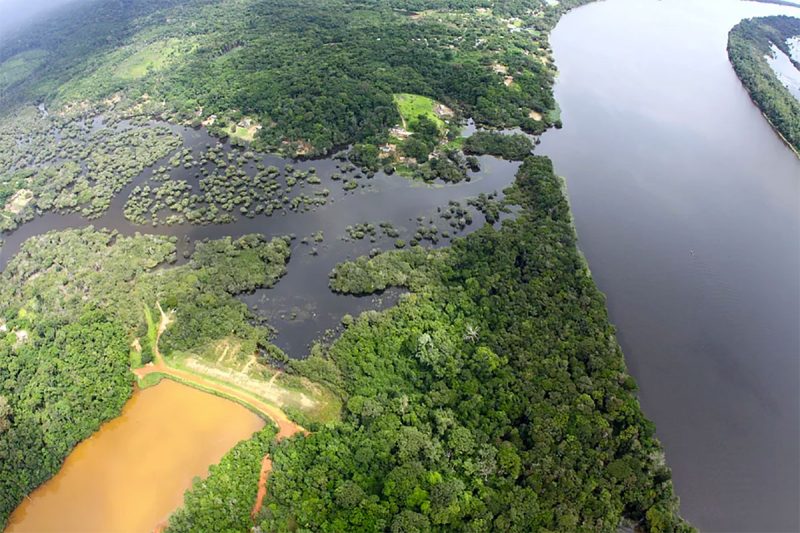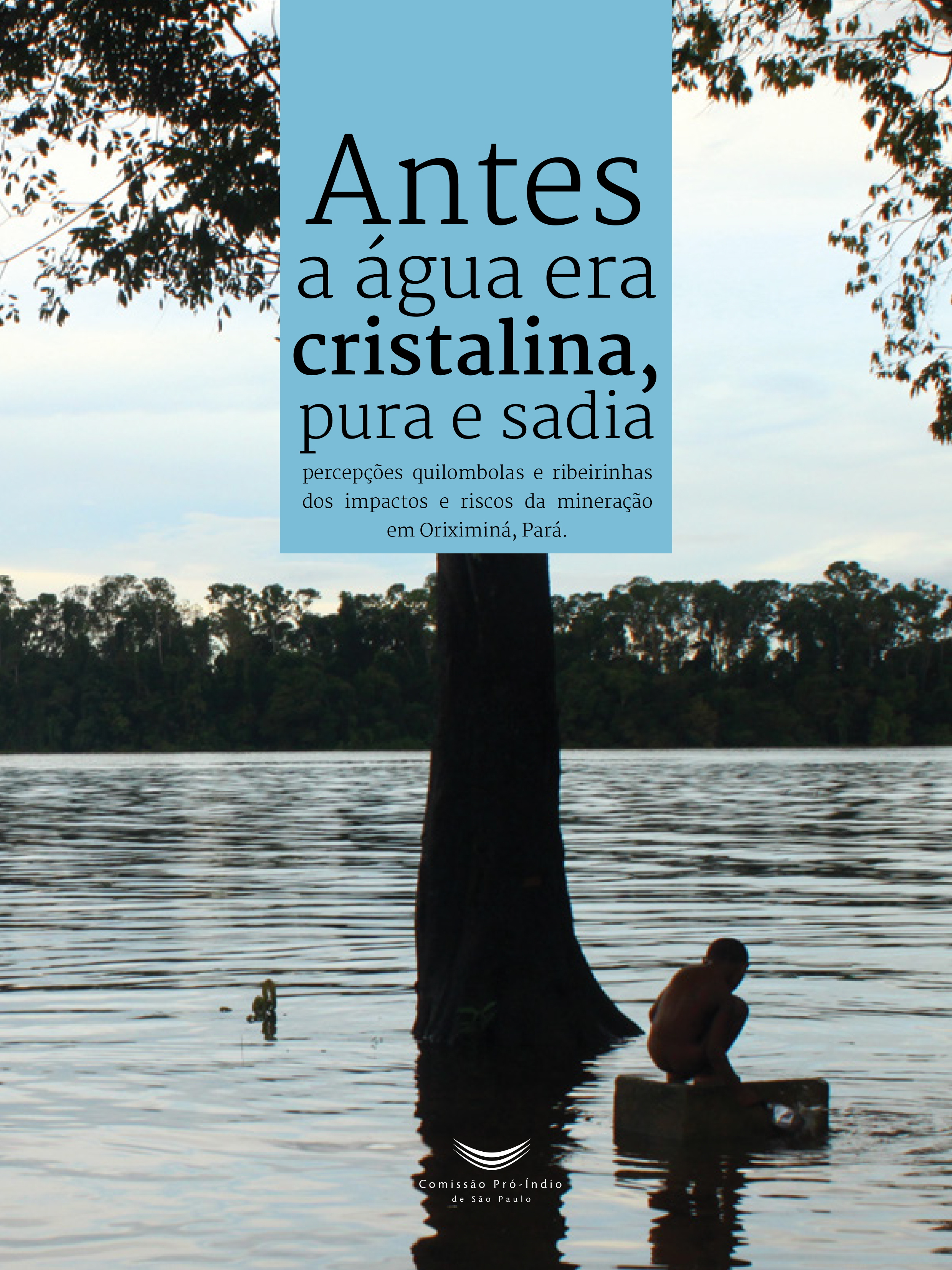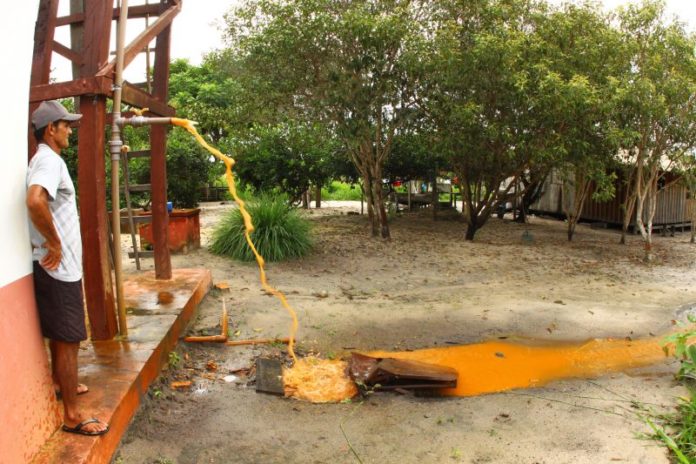In a book released by the Comissão Pró-Índio de São Paulo this week, the affected population reveals the socio-environmental consequences of 40 years of bauxite extraction in Oriximiná, Brazil.
The book “Antes a Água era Cristalina, Pura e Sadia – Percepções quilombolas e ribeirinhas dos impactos e riscos da mineração em Oriximiná, Pará” [Before, the water was crystal clear, pure and healthy. Perceptions of the Quilombola and riverine communities on the impacts and risks of mining in Oriximiná, Pará] discusses the consequences of bauxite extraction from the point of view of the impacted population. The study gathers testimonies selected from 47 interviews carried out with residents of Quilombo Boa Vista, and the Boa Nova and Saracá riverine communities who report impacts on watercourses and reveal a feeling of insecurity about the risks of tailings dams that the company has built in the region. The mining takes place in the middle of the Amazon, inside a federal conservation unit (Saracá-Taquera National Forest), where quilombola and riverine communities live. The company Mineração Rio do Norte has as shareholders the giants Vale, Hydro, South32, Rio Tinto, Companhia Brasileira de Alumínio, Alcoa Alumínio S.A., Alcoa World Alumina and Alcoa Awa Brasil Participações. Bauxite, the raw material used in the production of aluminum, is sold in the national and international market (Asia, Europe and North America).“The water we have is not good quality water”
The quilombolas of Boa Vista and the ribeirinhos [riparians] of Boa Nova and Saracá point out the main consequences of changes in watercourses: the restriction of access to drinking water, the emergence of new diseases (affecting mainly children and women) and the reduction of fish stock.Jones da Luz from Boa Nova community, in his testimony to the study, also points out the concern with diseases: “We see that most families complain a lot of diarrhoea, from polluted water.” And regarding the reduction of fish, Jones says that “the fish we used to get, is not here anymore, ‘it’ thinks it is not good to be here, because the water is very polluted.” Quilombolas and riparians are skeptical about the information from Mineração Rio do Norte (MRN) that the water quality of the streams remains adequate. “Water researchers always come, every month they come to do this research, but nothing is ever detected. I do not believe that the water in this condition has nothing,” claims Maria de Fátima Viana Lopes, from Boa Nova community.Before, the water was crystal clear, pure and healthy. Today I’m afraid, it’s polluted. —Maria Zuleide Viana dos Santos, from Quilombo Boa Vista.
“We do not feel safe“
Another cause of concern for the residents of Boa Vista, Boa Nova and Saracá are the tailings dams of Mineração Rio do Norte. Data from the National Water Agency indicate that MRN is the fourth largest mining company in terms of number of dams in Brazil: 25 dams already in place, and there are plans to build more structures.Our community, we do not feel safe. The dams are big, we are afraid of them bursting. –Jones da Luz, Boa Nova Community They say Boa Vista is safe. Who guarantees that? –Aildo Viana dos Santos, Quilombo Boa Vista.The Boa Nova and Saracá riverine communities are located downstream of the tailings disposal system installed in the interior of Saracá-Taquera National Forest, which already has 23 dams. Quilombo Boa Vista is 430 meters away from two other sediment containment and water clarification dams located on the banks of the Trombetas River. Quilombolas and riverine residents resent the lack of transparency and dialogue on the part of the company and the governing bodies.
If any of them burst there, we don’t even know what to do because, until now, they have never given a lecture, never developed any study about this to give a positive result for us, the community members. -Ederson Seixas Santino, Saracá community.

Recommendations
The book presents a series of recommendations aimed at promoting the rights of quilombolas and riverine peoples to a healthy and balanced environment, safety and social control of mining activities that directly impact their lives. See the highlights below. To Ibama-Brazilian Institute of Environment and Renewable Natural Resources (Brazilian government body responsible for environmental licensing)- Examine the facts reported by the quilombolas of Boa Vista and the riverine communities of Boa Nova and Saracá on the impacts of the mining activity on water resources, and determine that those responsible adopt immediate measures to solve the problems encountered.
- Stipulate that the authorisation for Mineração Rio do Norte to implement new dams is subject to the carrying out of a specific socio-environmental impact assessment for the new structures, and the company’s abide by the recommendations indicated herein.
- Promote the reclassification of Associated Potential Damage of the A1 and Água Fria dams, in view of the potential impacts to the Boa Vista quilombolas and the Trombetas River Biological Reserve.
- Stipulate that the authorisation for Mineração Rio do Norte to implement new dams is subject to the company’s abide by the recommendations indicated herein.
- Ensure wide publicity of the results of the inspections by National Mining Agency in the dams of Mineração Rio do Norte for the society, in a format and content accessible to the communities located downstream of the dams.
- Examine the facts reported by the quilombolas of Boa Vista and the riverine communities of Boa Nova and Saracá on the impacts of the mining activity on water resources and adopt, in a short-term period, measures to solve the problems encountered.
- Accept IBAMA’s determination and proceed to review the risk classification of the A1 and Água Fria dams, putting them in High Associated Potential Damage.
- Promote adjustments to the Emergency Action Plan for the A1 and Água Fria Dams based on consultation and dialogue with the quilombolas of Boa Vista and on the Emergency Action Plan for the TP01 and TP02 Dams, based on consultation and dialogue with the Boa Nova and Saracá riverine communities.
 Antes a Água era Cristalina, Pura e Sadia – Percepções quilombolas e ribeirinhas dos impactos e riscos da mineração em Oriximiná, Pará [Before the water was crystal clear, pure and healthy. Perceptions of the Quilombola and riverine communities on the impacts and risks of mining in Oriximiná, Pará]
Comissão Pró-Índio de São Paulo
96 pages| 21 x 28 cm
Access the book in Portuguese here
Antes a Água era Cristalina, Pura e Sadia – Percepções quilombolas e ribeirinhas dos impactos e riscos da mineração em Oriximiná, Pará [Before the water was crystal clear, pure and healthy. Perceptions of the Quilombola and riverine communities on the impacts and risks of mining in Oriximiná, Pará]
Comissão Pró-Índio de São Paulo
96 pages| 21 x 28 cm
Access the book in Portuguese here

